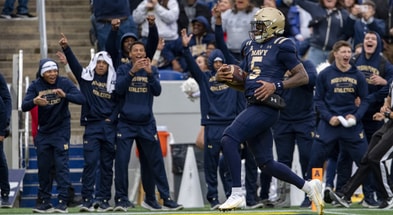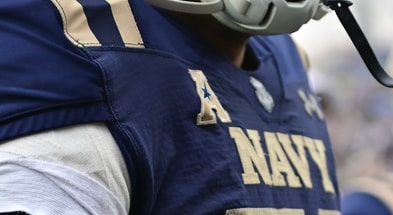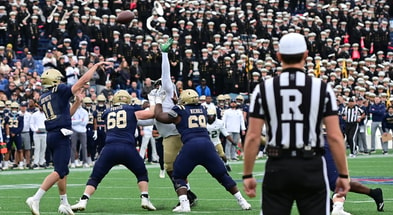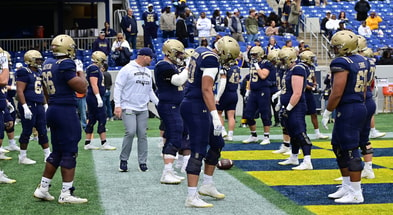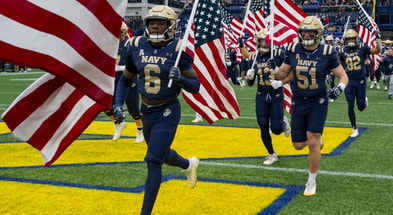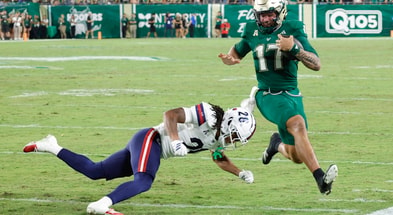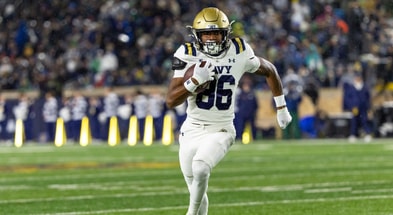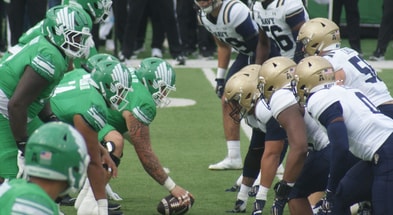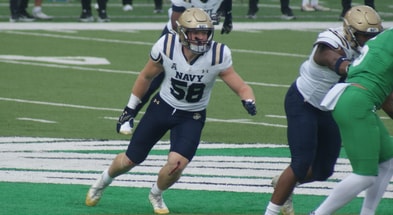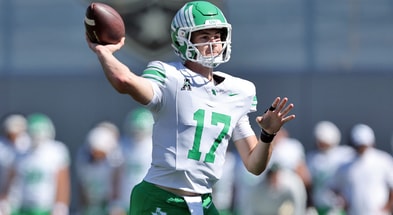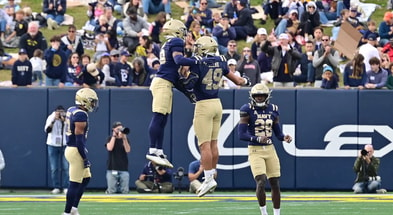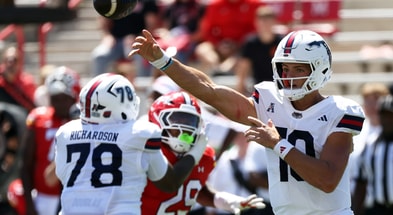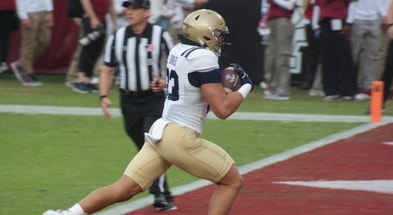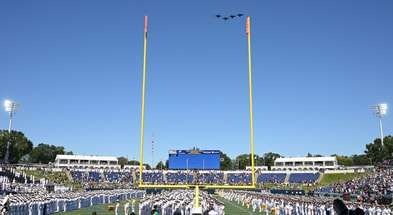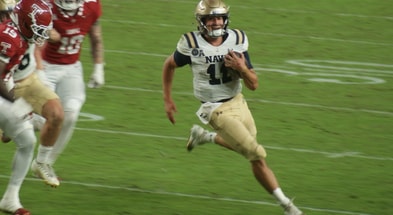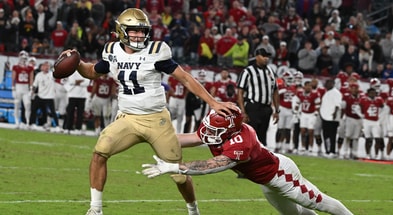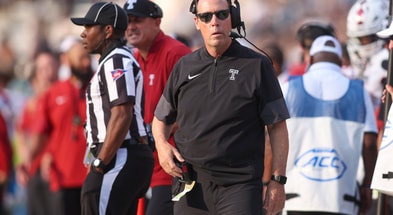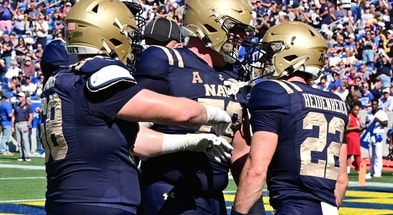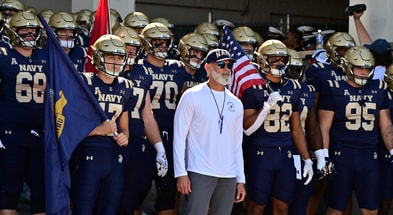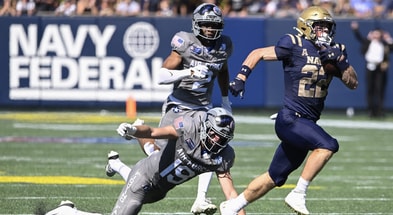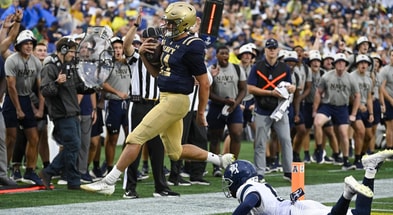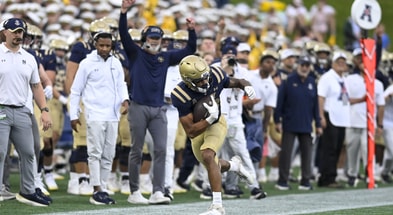The Memphis Preview
After four straight losing seasons, Navy football started the 2024 campaign with a new offense and something to prove. And after a 2-0 start, they seemed to be well on their way. But wins over Bucknell and Temple were only so convincing. It wasn’t until a win over a nationally ranked Memphis squad that people felt comfortable saying Navy was back.
It’s a role the Tigers have played on Navy schedule many times; sort of a greatness gatekeeper. Memphis is the only team that Navy has played every year since the Mids joined the American Conference. The Tigers are always one of the conference’s most talented teams, and as such, the two programs have made a habit of playing in pivotal games. In 2015, Navy’s win over the #15 Tigers catapulted them into the national spotlight. In 2017, Memphis returned the favor, getting a win over the #25 Mids that put the Tigers in the top 25 on the way to a West Division title. The 2018 game featured Malcom Perry‘s heroics. The 2019 game was a prime-time matchup of two teams that would go on to win 23 games between them. Whether or not you call it a rivalry, it’s a game both teams circle on their schedules.
And so it is once again, with the Mids and the Tigers set to face off in a prime-time Thanksgiving clash. Navy is fighting to stay alive in the race for the American Conference championship game, while Memphis comes in at 8-3 with hopes for a third-straight 10-win season.
It has been an interesting season for the Tigers, and by “interesting,” I mean I’m not sure how to interpret it. On the one hand, when you’re at the top of the conference’s NIL heap, you have high standards. You expect to contend for conference championships, so being 4-3 in the league and out of contention at this point stings. Memphis hasn’t won the American — or even appeared in the conference championship game — since 2019. They’ve lost two in a row and three out of their last five, including a stunner to hapless UAB.
On the other hand, they are still 8-3 in what could be considered a rebuilding year. Memphis had to replace quarterback Seth Henigan, a rare four-year starter at the same school. They returned only two starters on that side of the ball– both on the offensive line– and one starter on defense. They lost 90% of their receiving yards from last year, and losses from the linebacking corps cut into the heart of the defense. Yet the team spent three weeks in the top 25 and has wins over Arkansas and a ranked USF team under its belt. For a team with so many question marks heading into the season, they’ve done more than hold their own.
That’s because, in the transfer portal and NIL era, teams with money don’t have rebuilding years. When everyone builds a roster almost from scratch every season, programs with big budgets tend to do well. That wasn’t really the Memphis formula until this year, though. Even before the advent of the portal, Memphis was always one of the American’s most talented teams. For them, the portal was a way to augment the homegrown talent that was already there. This year, however, the Tigers had to replace more than usual. Between the portal and the recruiting class, Memphis has 78 new players on the roster, the most in the country.
For head coach Ryan Silverfield, then, this isn’t a rebuilding year as much as it is a transition year. The goal in the portal was to find proven, trusted players who can lead the team until the next core of young talent is ready to step up. And by that standard, they’ve been very successful. To replace Henigan, Memphis brought in quarterback Brendon Lewis, a senior who started for two seasons at Nevada, where he threw for 3,603 yards and ran for 1,270 more. At receiver, they brought in one of Lewis’s favorite Nevada targets, Cortez Braham Jr., who caught 56 passes in 2024. On defense, linebacker Sam Brumfield had 141 tackles across two seasons for Middle Tennessee State and Virginia Tech. These players give the Tigers a core group that has already proven itself on the field.
They also give the team a different character, especially offensively. With Henigan under center, the Tigers were much more of a downfield passing team. In 2023, they were 10th in the country in passes of 20 or more yards. Last year, they were 16th. This year, they’re 83rd, with 32. For comparison, UAB has 38, and Tulsa has 36. When Lewis throws, 62% of his passes are less than ten yards downfield, with 21% coming behind the line of scrimmage, thanks in part to the RPO being a much bigger part of the offense. Memphis has traded those downfield throws for a more diverse running game. Last year, Henigan ran for only 190 yards. This year, Lewis is second on the team with 582 yards and leads them with nine rushing touchdowns. A trio of running backs has combined for 1,406 yards and 21 touchdowns. It makes a total package that is one of the best rushing teams in the country, with the Tigers running for 192 yards per game. Their 5.2 yards per carry average ranks in the top 20, and their 34 rushing touchdowns are fourth, one fewer than Navy.

The shift in emphasis makes this an intriguing matchup for the Mids. In past years, Brian Newberry has always stressed preventing the deep ball when playing Memphis. And while the Tigers are still plenty capable of throwing deep, that isn’t their bread and butter the way it used to be. Is a more run-focused offense a better matchup for Navy? Well, maybe. When you’re still searching for the right players for your secondary, you would prefer not to have them tested as much. But #1 on the rushing touchdown list is North Texas, and tied with Memphis at #4 is Notre Dame. Good offenses are good offenses; Navy will have its hands full either way.
In fact, it isn’t hyperbole to say that Memphis offensive coordinator Tim Cramsey has dominated Navy. His offenses have averaged 497 yards per game against the Mids, including his time at Marshall. He is 3-1 against Navy, and he still had 659(!) yards in the one loss. One should assume that he will have plenty of answers for the Navy defense until proven otherwise.
One curveball that may work in Navy’s favor is Lewis’ health. A nagging ankle injury has plagued him, and in his weekly press conference, Silverfield didn’t deny it.
“Look, we all know since the injury occurred, he hadn’t been full speed,” Silverfield said. “A lot of guys are chipped up this time of year, as they should be with the amount of banging and the physicality of this game and the way he plays the game. He’s doing everything to prepare the right way. He’s going to battle as long as he can, but he’s done a great job of taking care of himself, and the expectation is that he’ll be our starter for this game.”
Battling “for as long as he can” doesn’t exactly inspire confidence, although that may just be coaching obfuscation. Still, the numbers tell the tale. Over the first half of the season, Lewis averaged 70 yards per game on the ground and scored seven touchdowns. Since then, it’s 31 ypg and two touchdowns. I would assume that the week off only helped him to get his wheels back, but if not, it limits the whole offense. The Memphis offensive line allows 2.36 sacks per game, which is 101st in the country. The problem worsens when Lewis’ mobility is limited; the Tigers have given up eight sacks in their last two games. With a team that doesn’t throw downfield the way they used to, those are drive killers.
Then again, the Memphis defense is known to kill a few drives on its own. The Tigers are another high-pressure unit that creates havoc plays. Their 18 forced turnovers are 27th in the country, and their 6.82 tackles for loss per game are 15th. Brumfield has shown impressive range; his 89 tackles are third in the conference, while defensive backs Kamari Wilson and Chris Bracy have combined for 138 tackles. Memphis has three players in the American Conference’s top eight in tackles for loss: Brumfield (#1), Bracy (#4), and linebacker Drue Watts (#8).
Last year, however, that aggression got Memphis into trouble against the Mids. Memphis lined up in either a 3-4 or a 3-3-5, depending on Navy’s alignment. In the latter, they would take an outside linebacker and move him back as sort of a hybrid LB/safety. In both alignments, they would key on Navy’s presnap motion. When one of the snipes went in motion, the safety followed him. In the 3-3-5, it was the hybrid safety that followed. Meanwhile, the safety on the other side would read the motion and step up in run support.
You can see that plan pretty clearly here:
Navy attacked this with a two-fold approach. They ran just enough plays into the motion to convince the defense that their plan was sound, then ran counters and misdirection away from the motion, along with play action, to get their chunk plays. The Mids repeatedly capitalized on that backside aggression.
On the Mids’ first touchdown, the backside defensive end actually wins at the line of scrimmage, beating the cut block and forcing Blake Horvath to change direction. When he did, there were no defenders there to stop him because they had run with the motion.
The Mids also used motion to open up the middle of the field. Here, the motion man does a reverse pivot. When he started his motion, he became one safety’s responsibility, and that safety followed him when he reversed the other way. But when he started his motion, the safety on the opposite side took it to mean his assignment would be run support, since that was the case on every other play with motion on that side. The safeties ran to either side of the formation, which opened up the middle.
It was in the second half that Navy really got big plays from misdirection, starting with this touchdown pass to Brandon Chatman running a drag route against the grain.
Memphis didn’t adjust by backing off on their backside pursuit. Instead, they doubled down by shifting the linebackers toward the motion along with the safeties.
But that just opened things up even more. Horvath’s last touchdown came on a variation of the power read. On this play, though, instead of the quarterback running on the motion side of the play, he ran away from it. Horvath’s read here is the down lineman over the B gap. If he got a give read, he’d hand it off, and the play would be a jet sweep. Instead, he got a keep read, and with the linebackers and safeties following the jet sweep motion, there was a whole lot of open field in front of him.
In his press conference, Silverfield took the fall for last year’s game, blaming poor preparation.
“Last year, no excuses, no explanations,” he said. “They came off a bye. We had prepared for a unique thing. We had studied all of Mercer’s film, where the offensive coordinator came from, and they gave us 22 plays we had not seen. We weren’t prepared and ready for that offense.”
So now the question is how last year’s lessons translate into this year’s plan. We may have gotten a sneak preview when the Tigers played Rice. The Owls are a shotgun option offense, and probably the closest thing we have to a direct comparison to Navy. Memphis dominated that game, 38-14, limiting Rice to 112 rushing yards and 2.4 yards per carry. It was 28-0 before the Owls had a single first down.
In that game, Memphis lined up the same way they did against Navy, with both a 3-4 look and a 3-3-5 look. But the mechanics were a little different. In a 3-4, they played man coverage and avoided overpursuit. The playside safety broke on the motion man, since that was his assignment. The backside safety shifted that way but didn’t break on the ball.
When Memphis lined up in a 3-3-5, the middle safety followed the motion, while the other two stayed in coverage:
That way, Memphis sort of had its cake and ate it too. They could stay aggressive on the perimeter while not exposing themselves to misdirection as much.
Of course, there are tradeoffs this way. Man coverage can leave you vulnerable to play action, and having three deep safeties can make you light in the tackle box. Rice isn’t a downfield passing team, so the former wasn’t much of a problem for the Tigers. As for the latter, Memphis just overwhelmed the Rice offensive line. They used unconventional run fits:
They twisted on the defensive line:
And sometimes they just won physically:
When Navy played Rice, the result was similar.
But how much of this translates to defending Navy? I’m not sure. The Mids are much more of a downfield passing team and much less of a zone running team than the Owls. When Silverfield was asked about the similarities, he said that there are some things he’ll want to carry over to build on what his team has already learned, but acknowledged that Rice and Navy are different animals.
“I think you want to try to keep as many similarities week to week, whether it’s offense, defense, special teams, because of the retention,” he said. “Ultimately, we’re going to say, ‘Okay, what do we think worked versus Rice and can it carry over?’ And if it can, great. But obviously, Navy has some things that are different than Rice for sure with what they do.”
Again, anything that comes from a coach’s press conference should be taken with a grain of salt. My gut feeling is that Memphis will look a lot different defensively.
In fact, the only thing you can really feel comfortable saying about this game is that it’ll be different from last year. Memphis has a new-look offense, and after taking their lumps against Navy in 2024, they are sure to have some surprises defensively. The Mids got off to a hot start against USF, but they’ll have to be ready to adjust on the fly if they want to do the same on Thursday.
Other than in 2020, when everything was abnormal, this is the latest that Navy and Memphis have met during the season. It’s usually a launching pad for one of them, but this year, it’s a grand finale. The Mids can already look at 2025 as a good year, but a win on Thursday can help make this a great year. Very few teams get a chance to play their last conference game with all of their goals still on the table. Here’s hoping Navy makes the most of it.
